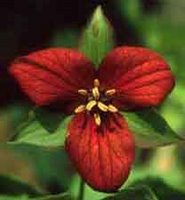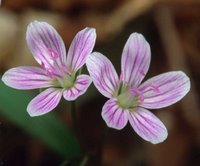 A handsome plant found in our open woods, Red Trillium bears big, three-petaled purple flowers in spring. The flowers are pretty, but they don’t mean to be. In fact, they mimic dead meat. The petals wear the color of carrion and the flower itself reeks with an odor among the most foul in nature.
A handsome plant found in our open woods, Red Trillium bears big, three-petaled purple flowers in spring. The flowers are pretty, but they don’t mean to be. In fact, they mimic dead meat. The petals wear the color of carrion and the flower itself reeks with an odor among the most foul in nature.
The fakery is the trillium’s way of drawing flies. Unlike the many bee-oriented flowers, trillium uses flies for pollination. These are the same flies that explore the recently thawed forest floor, feeding on the carcasses of creatures that died over the winter. To a fly, a trillium looks and smells just like another spring corpse.
Unfortunately for trillium, the burgeoning numbers of White-tailed Deer have significantly cut its numbers in many areas.
It takes more than bad breath to offend a hungry deer.




